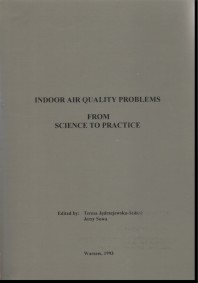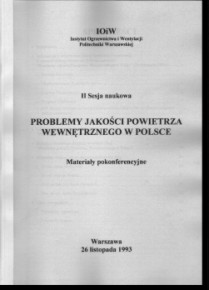II Konferencja
“Problemy jakości powietrza wewnętrznego w Polsce”
26
listopada 1993 rok
- połączona z Międzynarodową
Konferencją Naukową
“Indoor Air Quality Problems – From Science to
Practice”
odbywającą się w dniach 24÷26
listopada 1993 r.
[powrót
do II konferencji], [sesja naukowa]
Dorobek naukowy Międzynarodowej Konferencji Naukowej "Indoor
Air Quality Problems - From Science to Practice" oraz II Konferencji
"Problemy jakości powietrza wewnętrznego w Polsce" podsumowują dwie publikacje
 |
-
Indoor Air Quality Problems from Science to Pratice
Edytorzy: prof. dr hab. inż. Teresa Jędrzejewska - Ścibak,
dr inż. Jerzy Sowa.
ISBN: 83-901146-0-7, 412
stron.
Wydawnictwa Instytutu Ogrzewnictwa i
Wentylacji
Politechniki Warszawskiej, 1993
Wydawca: Wydawnictwa Instytutu
Ogrzewnictwa i Wentylacji
Politechniki Warszawskiej,
ul. Nowowiejska 20, 00-653 Warszawa
Publikacja dotowana przez Komitet Badań Naukowych
|
Spis treści:
KEY NOTE LECTURE
Current indoor climate problems and their possible
solution.
David P. Wyon, Sweden.
MODELLING AND MEASUREMENTS: TO WHAT EXTENT THE DESCRIPTION OF INDOOR ENVIRONMENT MAY REFLECT REALITY
Homogeneous and heterogeneous processes in the transport
of outdoor air pollutants indoors.
James W. Axley, John B. Peavey , Allyson L. Hartzel , USA.
Ventilation and air-quality prediction in industrial
environments: comparison of numerical and experimental results.
E. Nobile, G. Pittari, D. Pozzetto, S. Tommasi, Italy.
Presentation of experimentation on gravity transfers of a gaseous
pollutant.
Michel Cohas, Alain Grelat, Marie Claude Lemaire, Roland Fauconner, Didier Creuzevault, Jean Claude Loewenstein, France.
Development of multizone air flow model for indoor air quality
studies: A case study for multi-storey buildings.
Marian B. Nantka, Henryk Glinski, Poland.
Natural ventilation in multi-family dwelling houses at simulated
heat season climate conditions - numerical prediction and analysis
Andrzej Baranowski, Poland.
Indoor air quality assessment in a new office
building. General methodology and identification of odorous components emitted by carpets. A case
study.
B. Packebusch; P. Pluschke, Germany.
How could measurements help in solving IAQ
problems?
Claude-A. Roulet, Switzerland.
The stereothermometer: a new instrument for hygrothermal mocroclimate
evaluation in practice.
M. V. Jokl, Czech Republic.
Man as a stochastic factor in IAQ
prediction.
Jerzy Sowa, Poland.
POLICIES AND REGULATIONS: HOW WE MAY EXPRESS REQUIREMENTS
The development of indoor air pollution standards
and ventilation requirements.
Leonard S. Levy, United Kingdom.
Setting and application of occupational exposure limits in The
Netherlands: A critical evaluation
V.J. Feron, J.H.E. Arts, C. Hoeksema, P.C. Noordam, C.L. Maas, The Netherlands.
How do we establish priorities for the amelioration of air
pollution?
George B. Leslie, United Kingdom.
World and Polish regulations for ventilation rates and natural
gas combustion products, standards, guidelines and practice.
Leszek Targowski, Poland.
Methodology of grounding the hygienic standards for factor combination
in the air of industrial premises.
Leonard A. Dobrovolsky, Ukraine.
IAQ vs. ENERGY CONSERVATION:
TECHNOLOGY, MARKET, POSSIBILITIES
Thermal comfort in heatloaded office rooms, cooled by ceiling cooling
and ventilated by displacement ventilation.
E. Mayer, Germany.
Optimization of IAQ, thermal comfort and energy consumption
with demand controlled ventilation systems.
Fariborz Haghighat, Canada.
Indoor air quality and air
conditioning.
Rino P. Coppola, Italy
Investigations of the total air change in
dwellings.
Krzysztof Kasperkiewicz, Jerzy A. Pogorzelski, Niels C. Bergsoe, Poland & Denmark
The conflict between ventilation provision and energy efficiency
within the United Kingdom housing stock.
Rodger E. Edwards, United Kingdom.
Super insulating windows technology; Purchasing program
competition by the Department of Energy Efficiency, DOEE, Sweden
Diana Avasoo, Sweden.
Indoor Air Quality vs. Energy Consumption. The role of
windows.
Diana Avasoo, Sweden.
Application of ARMAX's models in thermal diagnostic of industrial
building.
Bernard A. Zawada, Teresa Jędrzejewska-Ścibak, Jerzy Sowa, Poland.
Modelling of thermal behaviour of a room with indirect passive solar system.
Halina Koczyk, Andrzej Górka, Poland.
Prediction of long-term energy consumption in heated buildings
exploitation.
Halina Koczyk, Poland.
Analysis of thermal properties determinated factors of indoor thermal comfort
Iurica Pavol, Slovak Republic.
FROM SCIENCE TO PRACTICE EXAMPLES OF SUCCESSFUL RESEARCH APPLICATION
Practical results of the Indoor Air '93
conference.
Olli Seppänen, Finland.
IAQ problems and solutions in the Basque country
(Spain) related to natural and/or LPG usage in individual heating installations.
Martín Zorraquino, J.V.; Del Campo Díaz, V; García San José, R., Spain.
Perforated concrete floor modules: A pilot study of the pollution
potential of modules used for ventilation.
Christine Wiech, John T. Smith, United Kingdom.
Indoor environment and architecture.
Mária Urbánková, Romana State1ova, Slovak Republic.
Developing construction on healthy
dwellings.
Chen Qigao, China.
A simple fibre-filter system for the reduction of particle-bound contaminants
and allergenes in indoor air.
Lothar Erdinger, Heribert Quirrenbach, Markus Fischer, Sabine Knauer, Klaus
Hammes, Hans-Günther Sonntag, Germany & Switzerland.
Layers nonwoven filtrating fabrics.
Elżbieta Jankowska, Poland.
Paper-like structures from glass fibre for air
filtration.
Józef Dąbrowski, Henryk Gonera, Poland.
Analysis of application multi stage filtration system in ventilation
and air conditioning installations.
Anna Charkowska, Poland.
ENVIRONMENTAL HAZARDS. HOW WE MAY REDUCE RISK FACTORS AND THEIR HARMFUL INFLUENCE ON HUMAN
HEALTH
Indoor/outdoor air quality factors with respect to voc emissions from vehicles
Roger Perry, Ivan L. Gee, United Kingdom.
Indoor air chemical pollutants and analytical problems
related to their determination
J. Namieśnik, B. Zygmunt, B. Kozdron-Zabiegała, Poland.
Medical investigation of airways hypersensitivity in problem
buildings.
Stefan Willers, Sweden.
Indoor radon concentration of East
Slovakia.
Ingrid Šenitková, Slovak Republic.
The contamination of indoor air by building
materials.
Adam Niesłochowski, Elżbieta Kazimierczak, Poland.
Microbiological monitoring of ventilation system in indoor
environment: the importance of correct cleaning and sanatisation.
Roberto Ligugnana, Italy.
Air microflora as estimation of sanitary and hygienic state
of accommodations and human beings' health.
Bolesław Krzysztofik, Poland.
Detection of magnetic aerosols deposition in animals exposed
to indoor and outdoor air pollutants.
Reichrtová E., Takáe L., Vrabeek P., Zrubec V., Maoka J., Slovak Republic.
Toxic influence dose for inhalation of beryllium (basis and
interpretation).
Vadim M. Malykhin, Russia.
NON TYPICAL IAQ PROBLEMS HOW WIDE IS THE AREA OF IAQ
INTEREST?
Determination of narcotic gases in the ambient air of operating theaters
by infrared spectrometry.
Heribert Quirrenbach, Michael Huber, H.K.Geiss, Lothar Erdinger, Germany.
Haloform concentrations in indoor swimming pool
air.
P. Mannschott, L. Erdinger, H.-G. Sonntag, P. De Biasi, S. Dieter, D. Kohlmüller, W. Kochen, Germany.
An investigation of the level of indoor air NO2 , O3 and ion in X-rays rooms
of the hospitals in Wuhan City.
Zeng Qing-Xiang, Chen Xian-De, Wang Guo-Fang, Dai Zhong-Hua, Lu Hong-Sheng, China
Prevalence of impaired lung function in traditional batik factory workers
exposed to batik fumes and other pollutants
Haryoto Kusnoputranto, Santoso, Umar Fahmi Achmadi, Indonesia.
Test measurements of light microclimate in the large textile produce
manufacturing halls.
Dušan Katunský, Slovak Republic.
Ventilation of the hyperbaric chambers: ventilation for moisture
removal.
T. Kozak, A. Majchrzycka, Poland.
Atmospheric control in the hyperbaric facilities during saturation
diving.
R. Kłos, A. Majchrzycka, Poland.
 |
-
Problemy jakości powietrza wewnętrznego w
Polsce
Materiały pokonferencyjne
Warszawa, 26 listopada 1993
Publikacja dotowana przez Ministerstwo Edukacji
Narodowej
|
Spis treść:
| • |
Przedmowa |
| • |
Informacja
o międzynarodowej konferencji naukowej, w ramach której odbyła się II
Sesja naukowa "Problemy Jakości Powietrza Wewnętrznego w
Polsce", 26 listopada 1993r. |
|
∙ |
Komitet
Honorowy |
|
∙ |
Międzynarodowy
Komitet Naukowy |
|
∙ |
Komitet
Organizacyjny |
|
∙ |
Program
Konferencji |
|
∙ |
D.P. Woyn,
"Obecne problemy klimatu wewnętrznego i ich możliwe rozwiązanie",
referat zamówiony |
|
∙ |
Cl.A. Roulet,
Sprawozdanie z konferencji |
| • |
List
intencyjny organizatorów II Sesji naukowej "Problemy Jakości
Powietrza Wewnętrznego w Polsce" |
| • |
Relacja z
przebiegu dyskusji w trakcie Sesji "Problemy Jakości Powietrza Wewnętrznego
w Polsce" |
| • |
Materiały złożone
do druku po zakończeniu sesji |
|
∙ |
dr inż. Anna
Mołocznik |
|
∙ |
dr inż.
Marian Nantka |
|
∙ |
prof. dr hab.
inż. Jacek Namieśnik |
|
∙ |
doc. dr inż.
Adam Niesłochowski |
| • |
Lista
uczestników |
|
∙ |
Uczestnicy
zagraniczni |
|
∙ |
Uczestnicy
krajowi |
[powrót
do II konferencji], [sesja naukowa]
Strona
główna
Copyright © 2001-2019 Wydział Instalacji Budowlanych, Hydrotechniki i Inżynierii Środowiska, PW. All rights reserved.
Ostatnie uaktualnienie: 04 grudnia, 2001.

